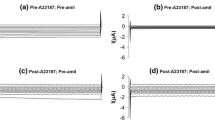Abstract
The macula densa cells of the juxtaglomerular apparatus probably serve as the sensor cells for the signal which leads to the appropriate tubuloglomerular feedback response. The present study reports basolateral membrane voltage (PDbl) measurements in macula densa cells. We isolated and perfused in vitro thick ascending limb segments with the glomerulus, and therefore the macula densa cells, and the early distal tubule still attached. Macula densa cells were impaled with microelectrodes under visual control. PDbl was recorded in order to examine how these cells sense changes in luminal NaCl concentrations. The addition of furosemide, a specific inhibitor of the Na+2Cl−K+ cotransporter in the thick ascending limb, to the lumen of the perfused thick ascending limb hyperpolarized PDbl from −55±5 mV to −79±4 mV (n=7). Reduction of NaCl in the lumen perfusate from 150 mmol/l to 30 mmol/l also hyperpolarized PDbl from −48±3 mV to −66±5 mV (n=4). A Cl− concentration step in the bath from 150 mmol/l to 30 mmol/l resulted in a 24±4 mV (n=4) depolarization of PDbl. This depolarization of PDbl was absent when furosemide was present during the Cl− concentration step. These data suggest that the macula densa cells sense changes in luminal NaCl concentration via coupled uptake of Na+ and Cl−. The transport pathways for NaCl transport in macula densa cells are probably identical to those in the thick ascending limb: the (Na++K+)-ATPase in the basolateral membrane drives Na+ and Cl− uptake via the luminal Na+2Cl−K+ cotransport, Cl− leaves the cell via basolateral Cl− channels and K+ recycles across the apical membrane via K+ channels. Changes in intracellular Cl− activity as a result of altered luminal NaCl uptake, and thus voltage changes of the basolateral membrane are probably the first signal in the tubuloglomerular feedback regulation.
Similar content being viewed by others
References
Bell PD (1986) Assessment of tubuloglomerular feedback signal transmission in vitro using glomerular quin-2 fluorescence. Proc 30th Int Congr Physiol 26: P 114.12
Boberg U, Wright FS (1988) Distal NaCl concentration as signal for the tubuloglomerular feedback mechanism. In: Persson AEG, Boberg U (eds) The juxtaglomerular apparatus. Elsevier, Amsterdam, pp 89–96
Briggs JP, Kokko JP, Jacobson HR (1984) Dissection and in vitro microperfusion of the juxtaglomerular apparatus. Proc 11th Int Congr Nephrol 406A
Briggs JP, Schnermann J, Skott O (1988) Macula densa transport: direct and indirect approaches. In: Persson AEG, Boberg U (eds) The juxtaglomerular apparatus. Elsevier, Amsterdam, pp 79–87
Gonzales E, Salomonsson M, Müller-Suur C, Persson AEG (1988) Measurements of macula densa cell volume changes in isolated and perfused rabbit cortical thick ascending limb. I. Isosmotic and anisosmotic cell volume changes. Acta Physiol Scand 133:149–157
Greger R (1981) Cation selectivity of the isolated perfused cortical thick ascending limb of Henle's loop of rabbit kidney. Pflügers Arch 390:30–37
Greger R, Hampel W (1981) A modified system for in vitro perfusion of isolated renal tubules. Pflügers Arch 389:175–176
Greger R, Schlatter E (1983) Properties of the basolateral membrane of the cortical thick ascending limb of Henle's loop of rabbit kidney. A model for secondary active chloride transport. Pflügers Arch 396:325–334
Greger R, Schlatter E, Lang F (1983) Evidence for electroneutral sodium chloride cotransport in the cortical thick ascending limb of Henle's loop of rabbit kidney. Pflügers Arch 396:308–314
Greger R, Oberleithner H, Schlatter E, Cassola AC, Weidtke C (1983) Chloride activity in cells of isolated perfused cortical thick ascending limbs of rabbit kidney. Pflügers Arch 399: 29–34
Kirk KL, Bell PD, Barfuss DW, Ribadeneira M (1985) Direct visualization of the isolated and perfused macula densa. Am J Physiol 248:F890-F894
Kriz W, Kaissling B (1985) Structural organization of the mammalian kidey. In: Seldin DW, Giebisch G (eds) The kidney: physiology and pathophysiology. Raven Press, New York, pp 265–306
Lapointe JY, Bell PD, Cardinal GRTM (1982) Direct measurement of the basolateral membrane potential (Vbl) from cells of the macula densa (MD) and the thick ascending limb (TAL). Proc Am Soc Nephrol 20:27
Navar LG, Bell PD, Thomas CE, Ploth DW (1978) Influence of perfusate osmolality on stop-flow pressure feedback responses in the dog. Am J Physiol 235:F352-F358
Odlind B, Beermann B, Selen G, Persson AEG (1983) Renal tubular secretion of piretanide and its effects on electrolyte reabsorption and tubuloglomerular feedback mechanism. J Pharmacol Exp Ther 225:742–746
Schnerman J, Ploth DW, Hermle M (1976) Activation of tubuloglomerular feedback by chloride transport. Pflügers Arch 362:229–240
Thurau K, Schnermann J (1965) Die Natriumkonzentration an den Macula Densa Zellen als regulierender Faktor für das Glomerulumfiltrat (Mikropunktionsversuche) Klin Wochenschr 43:410–413
Wangemann P, Wittner M, Di Stefano A, Englert HC, Lang HJ, Schlatter E, Greger R (1986) Cl−-channel blockers in the thick ascending limb of the loop of Henle. Structure activity relationship. Pflügers Arch 407 (Suppl. 2) S 128-S 141
Wright FS, Persson AEG (1974) Effect of changes in distal transepithelial potential on feedback control of filtration. Kidney Int 6:144A
Wright FS, Schnermann J (1974) Interference with feedback control of glomerular filtration rate by furosemide, triflocin and cyanide. J Clin Invest 53:1695–1708
Author information
Authors and Affiliations
Additional information
This study was supported by “Deutsche Forschungsgemeinschaft” Gr. 480/9
Rights and permissions
About this article
Cite this article
Schlatter, E., Salomonsson, M., Persson, A.E.G. et al. Macula densa cells sense luminal NaCl concentration via furosemide sensitive Na+2Cl−K+ cotransport. Pflugers Arch. 414, 286–290 (1989). https://doi.org/10.1007/BF00584628
Received:
Revised:
Accepted:
Issue Date:
DOI: https://doi.org/10.1007/BF00584628




